Equine Massage: A Practical Guide (16 page)
Read Equine Massage: A Practical Guide Online
Authors: Jean-Pierre Hourdebaigt

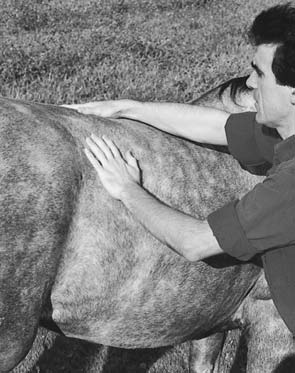
70
Equine Massage
3.17 Petrissage:Wringing
3.18 Wringing Movement
Movement
muscle mass worked on. Remain light when going over bony areas such as the spine, scapula, or point of the hip.Your rhythm should be smooth, and average 1 stroke per second or less.A faster rhythm (2 strokes per second) will be very stimulating and may be irritating to the horse.
Skin Rolling
Skin rolling is a very soothing manipulation that is used mostly to:
❖ Maintain a healthy and shining coat
❖ Prevent the formation of excess adhesions
❖ Maintain elasticity of the skin
With thumbs on one side and fingers on the other, grasp and lift the skin. Using either one or both hands (preferably both), push the thumbs forward, rolling the skin toward the fingers.The fingers draw the skin toward the thumbs, lifting, stretching, and squeezing the tissues effectively.
Skin rolling is a gliding movement that should be performed in a slow, soothing manner to avoid irritating the skin, especially over areas where the underlying tissues are close to the bone.The angle of direction may be varied and repeated to ensure maximum effect. This is a great technique to enhance circulation. Use only 2 or 3 pounds of pressure—maximum!
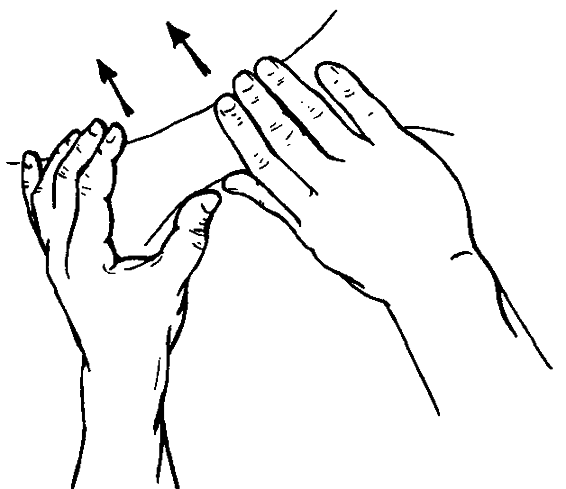
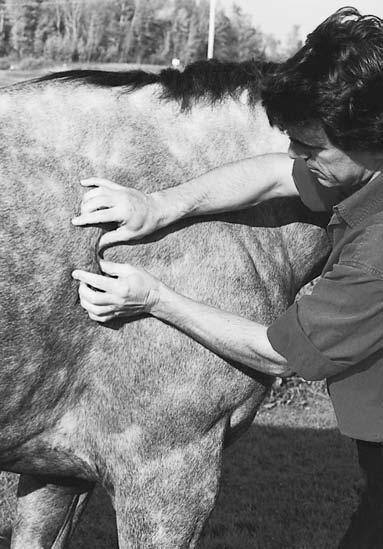
Principles and Concepts of Massage
71
3.19 Petrissage: Skin Rolling Movement
3.20 Skin Rolling Movement
Vibration
Vibration is mostly used to have an effect on the deeper structures (muscles or joints) that are below the superficial tissues.This quiv-ering type of movement is done with the hand. It has a soothing effect and can be used alone or as part of another routine.
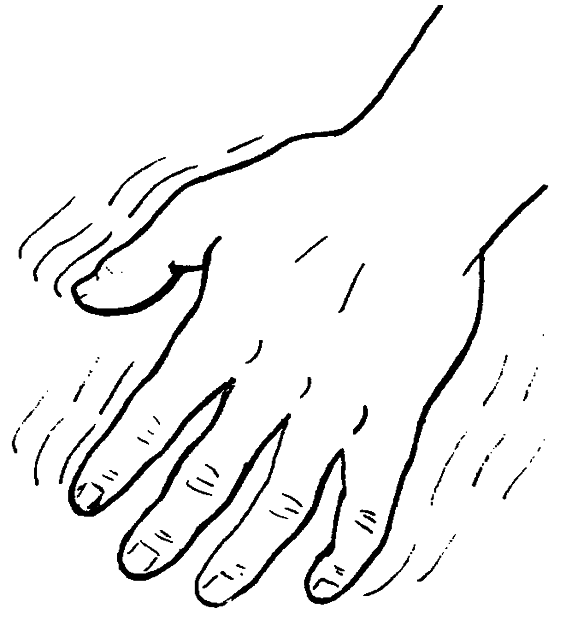
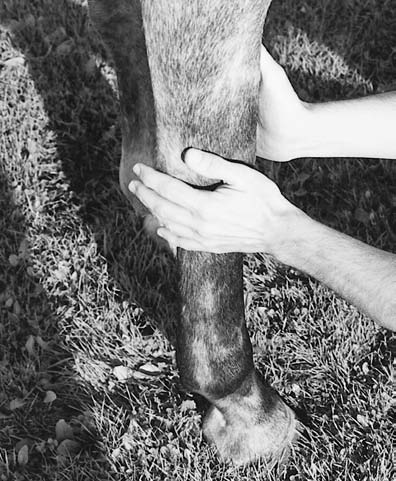
72
Equine Massage
3.21 Vibration Movement
3.22 Vibration Massage Movement
At the start, use no pressure other than the weight of your hand on the part to be vibrated (1 pound). Progressively increase your pressure by a few pounds to the point of stretching the structure you are treating. Start the vibration movements from the elbow and let them progress through your wrist to your hand; this is known as a “flat hand vibration.”
Principles and Concepts of Massage
73
Another variation, the “point vibration,” is done with the thumb or the fingertips only, giving you more accuracy for small, specific areas. Done gently, with 1 or 2 pounds of pressure vibrations have a mechanical, soothing effect with a strong nervous reflex effect.
When employed more heavily, with 2 to 5 pounds of pressure and at a faster, more aggressive rhythm, vibrations are a mechanically stimulating move and less of a nervous reflex.
This manipulation is very useful in relaxing the nervous system.
Use the flat-hand vibration move in a gentle manner (light pressure) over the sacrum for a couple of minutes when starting the relaxation routine. It is very efficient in eliciting the parasympathetic nervous response, reaching the central nervous system (brain) quickly. However, I do not recommend using this move directly over the head (skull).
Apply vibration to joints and around bony prominences. This will soothe swollen joints, whether caused by acute trauma or chronic injury.Vibrations are also good for inflamed rheumatism or arthritis where regular massage is contraindicated.
Use vibrations near well-healed scar tissue in order to reduce adhesions. Depending on the area, apply no more than 5 to 10
pounds of pressure until the animal’s maximum tolerance is reached.
Start with a small vibratory movement, maintaining it for a few seconds. Then gradually release and move to another position.
Start again and repeat over the whole area you want to treat.
Intersperse effleurage and stroking frequently with this move to drain the tissues and relax the animal.
A full treatment using this movement alone should not exceed 3
minutes over a small area or 5 minutes over a larger one. Determine the need relative to the degree of inflammation present.
Shaking
Shaking is a very strong mechanical movement used frequently in sports massage to increase circulation. Shaking is performed with either the fingertips or the whole hand in full contact with the body part.
When done in a gentle manner (1 stroke per second), it is soothing. When applied briskly (2 or 3 strokes per second), it is one of the most stimulating massage moves.
Pressure should be kept between 3 and 5 pounds.The skin can move with your hands over the body parts. When using heavier pressure and a faster rhythm, the hands glide over the skin. As you
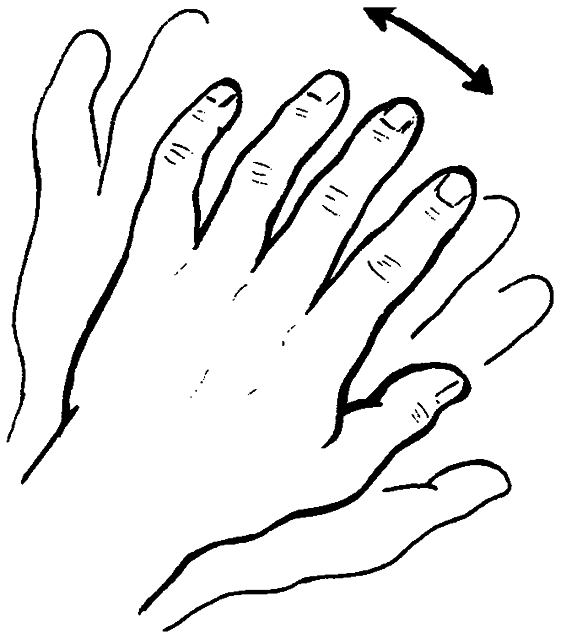
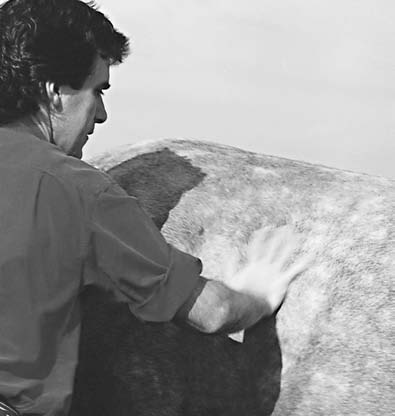
74
Equine Massage
3.23 Shaking Movement
3.24 Shaking Massage Movement
work in this manner, pay attention to feedback signs from your horse.Take care not to irritate the nerve endings of the skin, especially if an inflammation is present. Adjust your rhythm and pressure accordingly. Always ease off a little when going over bony processes such as the point of the hip or the scapular spine.
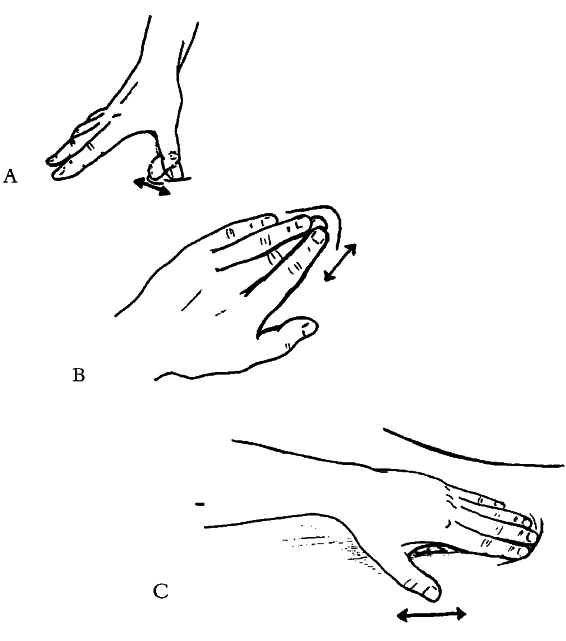
Principles and Concepts of Massage
75
Friction
This movement is mostly used in sports therapy to break down adhesions and scar tissue (fibrosis) over muscular fibers, tendons, ligaments, fascia, joint capsules, and bones. Always warm up the area thoroughly with effleurages, wringings, and kneadings before proceeding to frictions.
Frictions consist of small, deep, circular movements applied across the length of the muscle or up and down over a patch of fibrous tissue. Use the tip of your thumb or fingers when using this movement on small, local areas. Use both hands over large areas.
Friction can be done gently or strongly, depending on your aim. Both styles are mechanically stimulating to the body, causing increased blood circulation. Keep in mind the degree of tissue inflammation, the dimension of the adhesions, and their location in relation to other structures (bones, joints, or veins).
To break down fibrous adhesions you need to use a fair amount of pressure, starting at around 10 to 15 pounds of pressure, progressively building up to 30 pounds; adjust accordingly depending on your aim.Always warm up the area thoroughly before starting, and drain the area well when finished.
